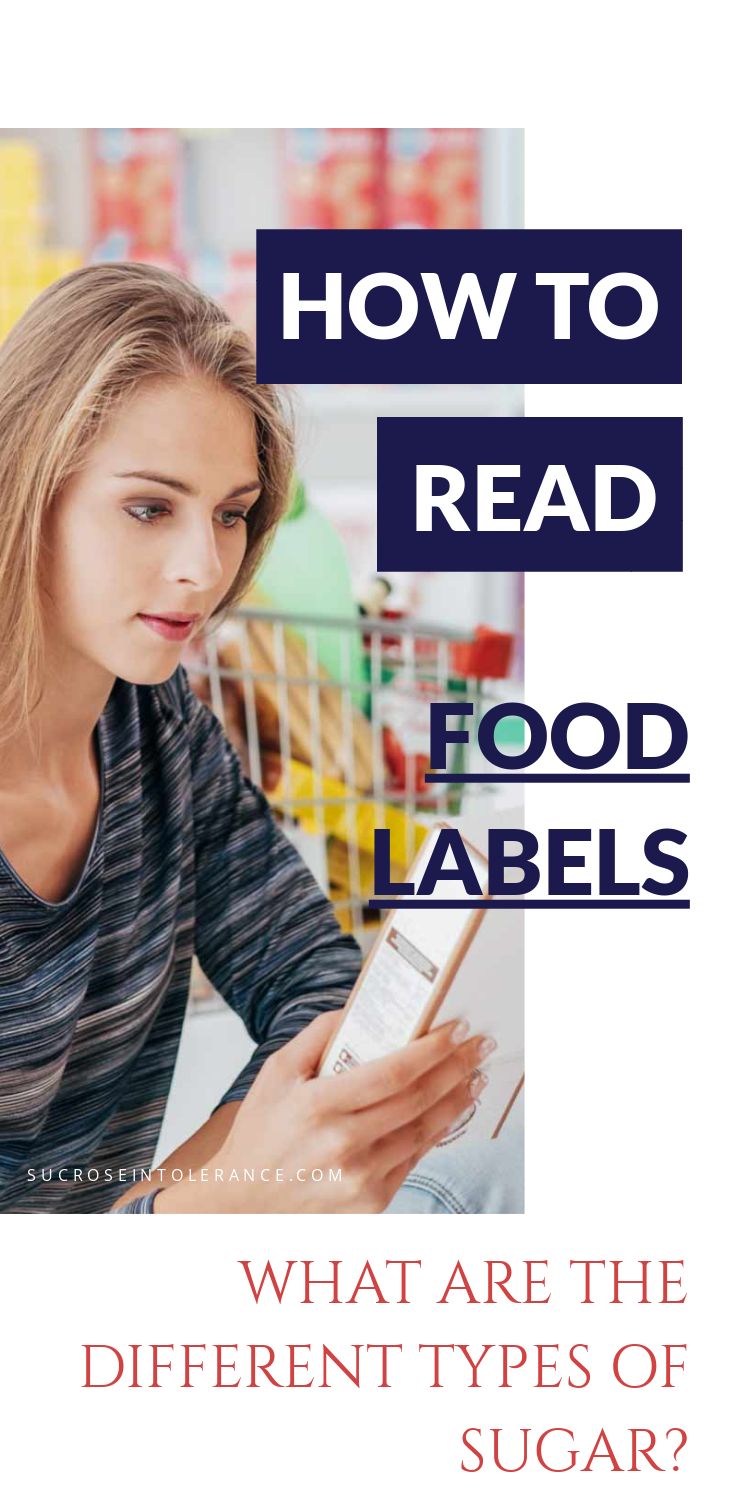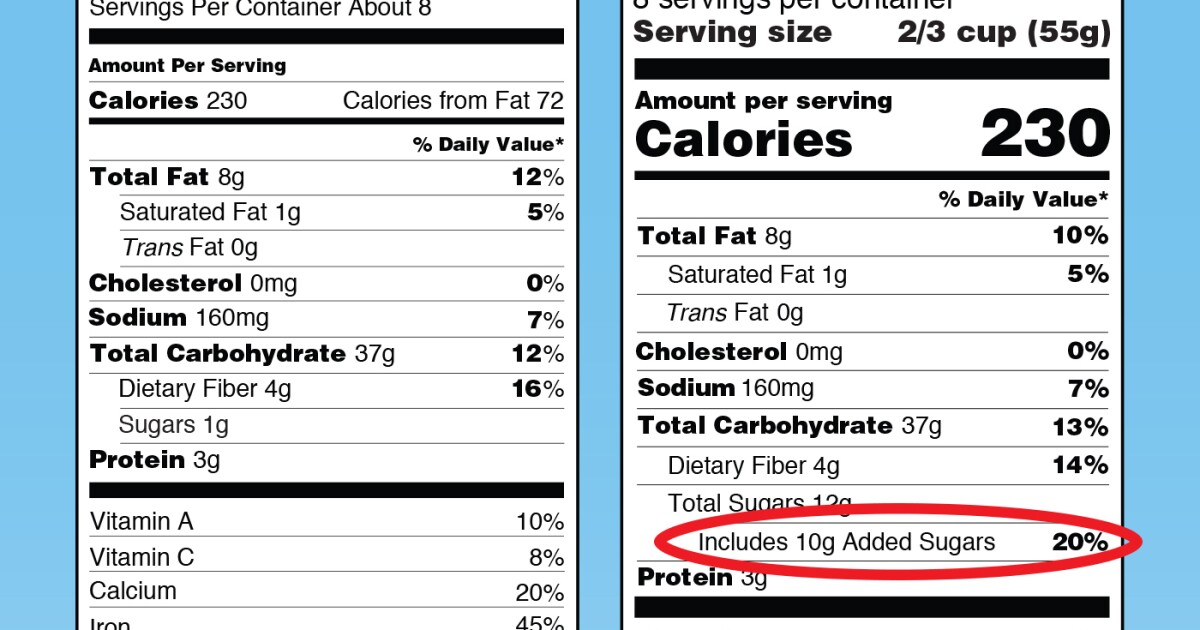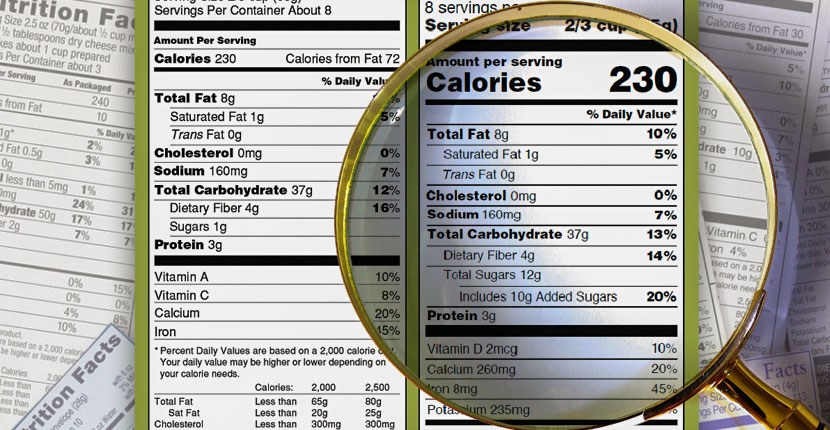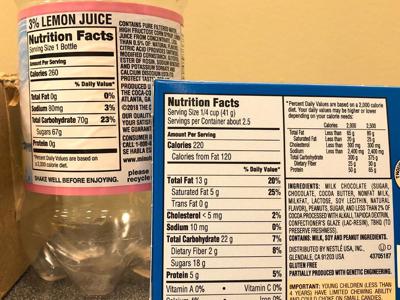44 how to read sugar labels on food
Food labelling - Making Sense of Sugar Sugars will be listed as carbohydrates (which usually include both starches and sugars) and will use the phrase “of which sugars” to show how much sugars there ... How To Spot Sugar On Food Labels | HUNGRY FOR CHANGE One of the easiest ways to recognize sugar on a food label is by recognizing the -ose suffix. When you find words that end in -ose, there's a good chance it is sugar. Sugars ending in -ose include: Sucrose, Maltose, Dextrose, Fructose, Glucose, Galactose, Lactose, High fructose corn syrup, Glucose solids
How to Understand and Use the Nutrition Facts Label | FDA - U.S. Food ... manufacturers are encouraged, but not required, to use the "†" symbol immediately following the added sugars percent daily value on single-ingredient sugars, which would lead to a footnote...

How to read sugar labels on food
Understanding food labels | Diabetes UK The labels show how many calories are in the food or drink and are also colour coded to show whether the food is low (green), medium (amber) or high (red) in fat, saturated fat, sugar and salt. The information on the front of the pack also tells you how the portion of the food contributes to the Reference Intake (RI) of an adult. How to Read Food Labels and Understand Sugar Content - yum. Gluten Free There may be further categories and/or subset of these categories, for example, 'sugars' is a subset of 'carbohydrates'. The amount shown for each of the nutrients is listed 'Per Serve' and 'Per 100 g' (or ml, for a liquid food). The question is, should you look at the 'Per Serve' or 'Per 100 g' column in the NIP? How to read food labels | Health Advice Hub - Laya Healthcare high – over 22.5g of total sugars per 100g · medium - between 5g-22.5g of total sugars per 100g · low – 5g of total sugars or less per 100g.
How to read sugar labels on food. Understanding food labels - Action on Sugar Step 1 - Calculate amount of sugars per gram by dividing the amount of sugars per 100g OR 100ml by 100. Step 2 - Check the weight of a recommended portion as stated on the pack. Step 3 - Work out the amount of there is per portion by multiplying the figures from step 1 and 2. How to read labels for added sugar - That Sugar Movement Three: Remember that 4g = 1 teaspoon of sugar Technically, 4.2g = 1 teaspoon of sugar, but for the easy on-the-spot calculation, just remember 4g equals one teaspoon. For example, a 375ml can of Coca-Cola is about 40g of sugar. Dividing that by 4 means there are 10 teaspoons of added sugar in the one can. safefood | How to read food labels To make healthier choices, you need to be able to make sense of food labels. Understanding food labels can be tricky. It takes time and practice. Start at home by getting familiar with labels on the foods you eat regularly. Then when you are shopping, compare labels of similar products to find the healthiest option. Here are the things to look ... Food Labels (for Teens) - Nemours KidsHealth Food labels provide more than just nutrition facts. They also tell you what's in a packaged food (i.e., the ingredients). People with food allergies need to check ingredient lists to avoid foods that can cause an allergic reaction. Some food labels also state which country the food came from, whether the food is organic, and certain health claims.
Food labels - NHS Colour-coded nutritional information tells you at a glance if the food has high, medium or low amounts of fat, saturated fat, sugars and salt: red means high amber means medium green means low In short, the more green on the label, the healthier the choice. Reading food labels: Tips if you have diabetes - Mayo Clinic Look for foods with 3 or more grams of fiber. Put sugar-free products in their place Sugar-free doesn't mean carbohydrate-free. Sugar-free foods may play a role in your diabetes diet, but remember that it's equally important to consider carbohydrates as well. A sugar-free label means that one serving has less than 0.5 grams of sugar. Learning To Read Labels :: Diabetes Education Online On a nutrition food label, subtract the fiber from the total carbohydrate amount. When you read food labels, the grams of sugar are already included in the total carbohydrate amount, so you do not need to count this sugar amount separately. The grams of sugar listed include both natural sugars, from fruit or milk, and added sugars. Reading Food Labels | ADA - American Diabetes Association The Nutrition Facts labels on foods are really the key to making the best choices. We'll cover the basics so that these labels make shopping easier for you. Get started. Understanding Carbs. You've heard it all. From carb-free to low-carb, to whole and empty carbs, it's hard to know what it all means. Learn more.
'Nutri-Score' label may counter misleading sugar claims on groceries ... A new analysis suggests that the Nutri-Score -- a label indicating the overall nutritional quality of a food product -- can counteract the misleading effects of sugar claims. Food Labels | CDC - Centers for Disease Control and Prevention Check the Serving size first. All the numbers on this label are for a 2/3-cup serving. This package has 8 servings. If you eat the whole thing, you are eating 8 times the amount of calories, carbs, fat, etc., shown on the label. Total Carbohydrate shows you types of carbs in the food, including sugar and fiber. Sugars on food labels - Sugar Nutrition Resource Centre Sugars and the Nutrition Information Panel The Nutrient Information Panel on the back of the pack, shows detailed information on the average amount of energy, protein, fat, saturated fat, carbohydrate, sugars and sodium (a component of salt) in the food, as well as any other claim that requires nutrition information. Added Sugars on the New Nutrition Facts Label | FDA - U.S. Food and ... Labels for foods and beverages with added sugars will list the number of grams and the percent Daily Value (%DV) for added sugars within the Nutrition Facts label. Having the word "includes" before...
Understanding food labels - Canada.ca Find information on food labels and how to understand them. Learn about nutrition facts tables, serving size, list of ingredients, % daily value and nutrition claims.
How to Read Food Labels Without Being Tricked - Healthline This label usually means that the fat has been reduced at the cost of adding more sugar. Be very careful and read the ingredients list. Low-carb. Recently, low-carb diets have been linked to...
Reading Food Labels When You Have Diabetes - WebMD Being able to read and understand food and nutrition labels is essential, especially for those with diabetes. ... At least 25% less fat or sugar than the regular product. Cholesterol free: Less ...

Listing added sugar on food labels would improve health and extend lives, study suggests | MinnPost
How To Read Food labels for Sugar | My Sugar Free Kitchen On the label check the sugars in the nutrition panel. 5g/ml or less of sugar per 100g/ml = this would count as low sugar content. It means 5% of the ingredients are sugar Between 5g/ml and 20g/ml of sugar per 100 grams = medium sugar content. With 20ml of sugar per 100 ml, this means the product is 20% sugar…not so good.
5 ways to spot added sugars on food labels - Tryon Medical Partners Raw sugar. 2. Look for the word "includes". Recently, the Food and Drug Administration mandated that manufacturers must list added sugars in grams and as a percentage of the Daily Value. Now food labels have the word "includes" before added sugars to indicate that added sugars are included in the number of grams of total sugars in the ...
Understanding sugar content on food labels - Diabetes Care Community Reading the ingredient lists and nutrition facts tables on packaged foods is a helpful way for you to check what kind, and how much, sugar a product has. Finding sugar content in the ingredients list The ingredients are listed in order of weight, beginning with the ingredient that weighs the most and ending with the ingredient that weighs the ...
This Is How to Read a Nutrition Facts Label on the Keto Diet Depending on the daily carb intake you've determined for yourself to stay in ketosis, this is a quick way to determine whether you have room in your daily eating plan for a particular food. (Remember, a ketogenic diet is typically a ratio of about 70-75% fat, 15-25%+ protein, and 5% or less of calories from carbs.)
What are the 4 steps to reading food labels? - clambaronline.com Reading Food Labels. Step 1: Check serving sizes and calories per serving. Step 2: Check the fat content. Step 3: Check the cholesterol content. Step 4: Check the sodium (salt) Step 5: Check the total carbohydrates and sugar. Step 6: Check the fiber. You can also check the percent DV (Daily Value) What are the 10 Steps to read food label? How ...
How to Spot Hidden Sugar on Food Labels! - Dr. Michelle Pfeffer Start by looking at the carbohydrate count on the nutrition label. Under carbohydrates you will see a total carbohydrate measurement and then a breakdown to sugars and fiber. If the sugar number is most of the carbohydrate number then there is more than a lot of sugar in that food item. Now, look at the ingredient list.
How To Read Food and Beverage Labels - National Institute on Aging Feb 24, 2022 · Sometimes, food and beverage packaging includes terms that may try to convince the consumer the food is healthy. To help avoid confusion, the FDA sets specific rules for what food manufacturers can call “light,” “low,” “reduced,” “free,” and other terms. This type of labeling may have little to do with how nutritious the food is.

The 61 names of sugar – Read the food labels for hidden sugar | Sugar detox recipes, Sugar detox ...
PDF How to Read the Food Label - University of California, Santa Cruz Sugar is listed separately and is included in the . total grams of carbs. It includes both naturally occurring sugar (like in fruit) and added sugar in syrups and processed food and drinks. Limit added sugars. Protein. Protein is in both plant and animal foods, such as beans, nuts, fish, poultry, meat, eggs, and dairy products.
How to Read Carbohydrates on Food Labels - GlycoLeap That would be around 15 to 30 g of carbohydrates. Snack = 15 - 30 g of carbohydrate. For the main meals (breakfast, lunch, dinner), 2 to 3 servings of carbs would be enough. That is about 30-45 g of carbohydrates. 3 servings of carbohydrates are about the size of 1 fist size of rice.
How to Read Nutrition Labels for Sugar - hekagoodfoods Where to Find the Nutrition Label You'll usually find the nutrition facts label on the side or back panel of a packaged food. Just under the "Nutrition Facts" header, you'll see a breakdown of serving size and calories per serving. We advise you to not make the mistake of ignoring the serving size.

The 61 names of sugar – Read the food labels for hidden sugar | Food labels, Hidden sugar ...
How to Read a Label - Natural Sugar versus Added Sugar Food labels lump together all forms of sugar under Carbohydrates. There are two forms of sugar in the food we eat. There is *natural sugar* in fruits and even vegetables called fructose and in dairy products called lactose - then there are ADDED sugars - white, brown or powdered sugar as well as high fructose corn syrup, maple syrup or honey in ...
How to read food labels | healthdirect Sugar: Sugar is a type of carbohydrate. It is better to choose healthier carbohydrates and to limit foods that are high in added sugars. Fibre: High fibre foods such as wholegrain bread and cereals improve digestion and help you to feel full.

How to Read Food Labels and Learn the Different Types of Sugar on Them. | Reading food labels ...
How to read food labels | Health Advice Hub - Laya Healthcare high – over 22.5g of total sugars per 100g · medium - between 5g-22.5g of total sugars per 100g · low – 5g of total sugars or less per 100g.
How to Read Food Labels and Understand Sugar Content - yum. Gluten Free There may be further categories and/or subset of these categories, for example, 'sugars' is a subset of 'carbohydrates'. The amount shown for each of the nutrients is listed 'Per Serve' and 'Per 100 g' (or ml, for a liquid food). The question is, should you look at the 'Per Serve' or 'Per 100 g' column in the NIP?
Understanding food labels | Diabetes UK The labels show how many calories are in the food or drink and are also colour coded to show whether the food is low (green), medium (amber) or high (red) in fat, saturated fat, sugar and salt. The information on the front of the pack also tells you how the portion of the food contributes to the Reference Intake (RI) of an adult.







Post a Comment for "44 how to read sugar labels on food"